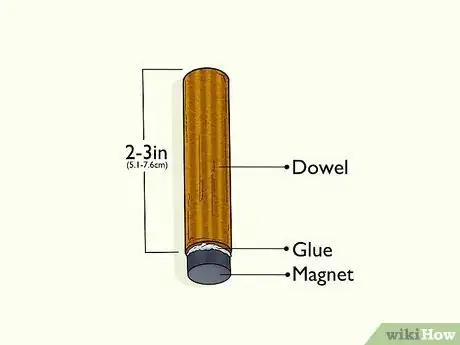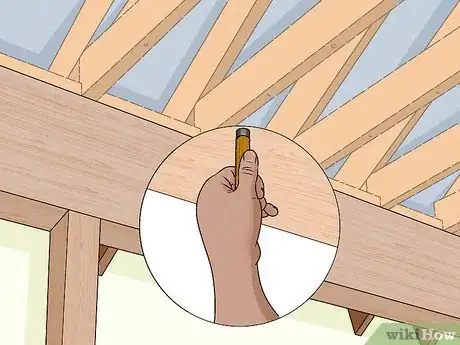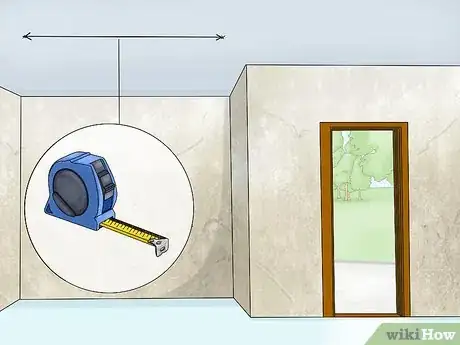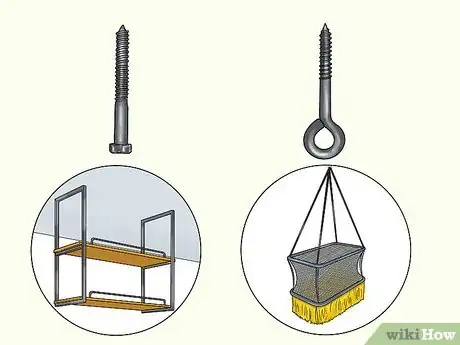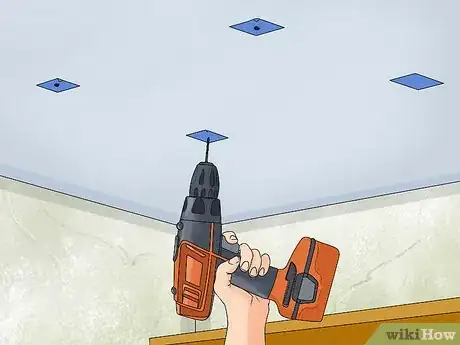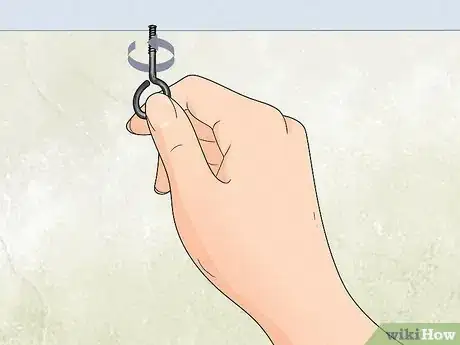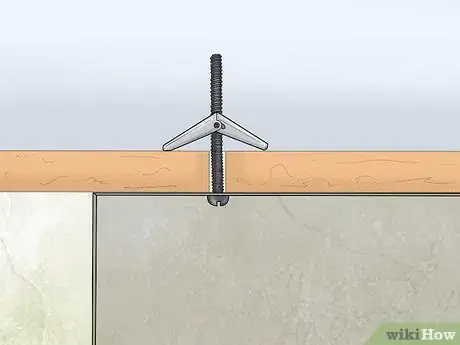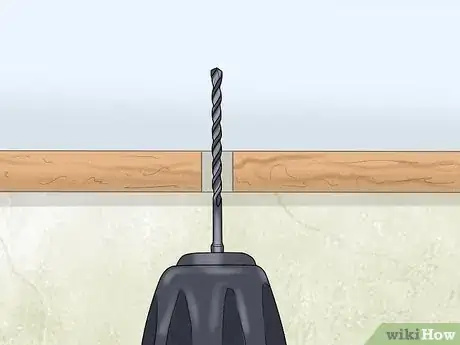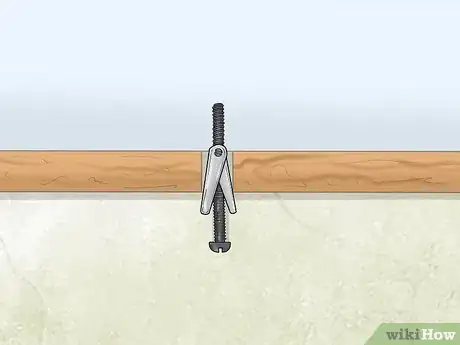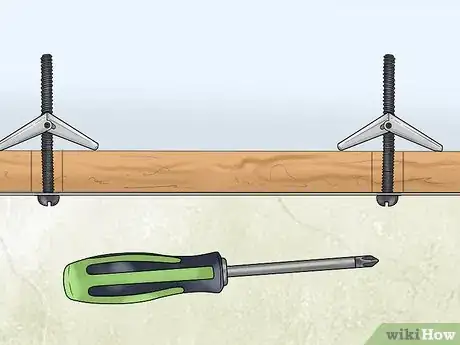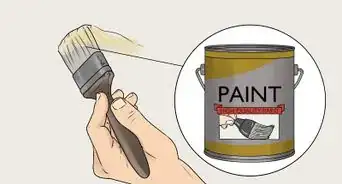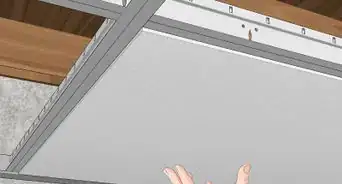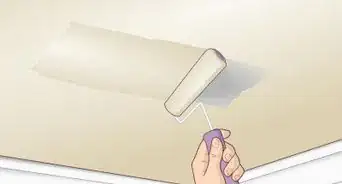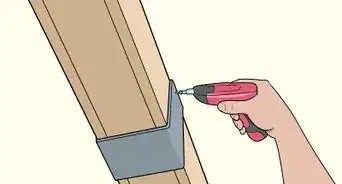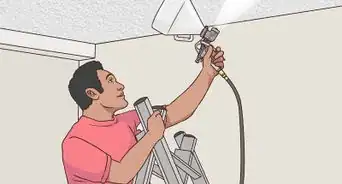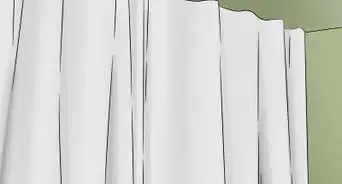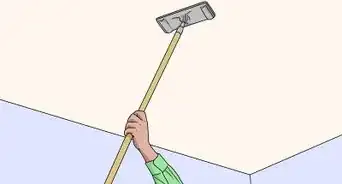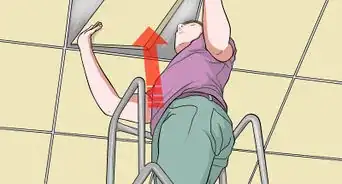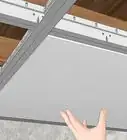This article was co-authored by Jason Phillip and by wikiHow staff writer, Janice Tieperman. Jason Phillip is a handyman specializing in mounting and hanging objects onto walls. With over five years of experience professionally mounting and installing objects through his company, Jason's Handyman Services, Jason's work includes working with mounting window AC units, designing art gallery walls, installing kitchen cabinets, and replacing light fixtures on drywall, brick, and plaster. He has been rated a "Top Pro" every year since 2016 by Thumbtack for being one of the highest-rated, most popular professionals on Thumbtack.
There are 15 references cited in this article, which can be found at the bottom of the page.
This article has been viewed 153,140 times.
From lights and fans to art and plants, hanging objects from the ceiling can make a room look more unique and stylish while opening up a lot of extra space. If your ceiling is supported with joists, attach the heavy object directly to the ceiling joist to provide extra support. If your ceiling is hollow, you can use toggle bolts to support your heavy object instead. It’s always best to consult a professional if you aren’t familiar with the structure of your home, but you may be able to redecorate your living space if you already have some home improvement experience under your belt.
Steps
Mounting Objects to Ceiling Joists
-
1Glue a strong magnet to the end of a small stick or dowel. Pick up a pack of strong earth magnets from your local craft store, then hot glue them to the bottom of the small stick or dowel that’s about 2 to 3 in (5.1 to 7.6 cm) long. Wait for the glue to dry completely so you can use the stick as an impromptu stud finder.[1]
- Earth magnets are super small, and are about the size of your pinky fingernail.
- You can take a branch from your backyard or local park and trim it down so it’s short.
-
2Locate the ceiling joist with your magnet. Climb up on a ladder so you can comfortably reach the ceiling with your arm. Hold the magnet up to the ceiling, moving it around as you search for the stud. Keep moving the magnet around until you feel it tug a bit. At this point, let go of the magnet and see if it holds in place. Shift the magnet around that area to get an idea of where the joist begins and ends.[2]
- A stud finder can be a bit difficult to maneuver on a ceiling, so a magnet might save you some time and trouble.
- It may take a few tries before you find the joist successfully.
- As a general rule of thumb, keep in mind that most joists are spaced 16 in (41 cm) apart.[3]
- Whenever possible, it’s best to hang a heavy object from a ceiling joist. That way, the item has plenty of support.
Advertisement -
3Mark the exact spot with a piece of painter’s tape. Rip off a small section of painter’s tape and place it exactly where the magnet is sticking, so you can remember where your joist is. Ideally, this joist will be around where you want to hang up your heavy object.[4]
- As an extra precaution, you can use a stud finder to find and mark both edges of your ceiling joist.[5]
-
4Take extra measurements if you’re hanging the item in more than 1 spot. Keep in mind that certain heavy objects, like a swing, may need to connect to the ceiling in more than 1 spot. Measure out the distance between these additional spots, taking time to mark them with a piece of painter’s tape or pencil.[6]
- For certain objects, like a swing, you’ll want to measure out at least 14 in (36 cm) of space in front and behind the joist so you have enough room to use the object.
- Double-check with a stud-finder or magnet to make sure any additional marks are still running along the joist.
- Some large objects must be supported in several places. For these, mount to more than one joist, and if necessary, use large toggle bolts where there is no joist.
-
5Choose a sturdy attachment that can hold your heavy object. Think about how much weight the attachment will be holding—if you’re hanging a piece of furniture, you may want to use lag bolts to mount the heavy object.[7] If you’re hanging something lighter, like a bassinet, you may want to use a screw-eye hook instead. Pick something with a thread that’s at least 2 1⁄2 in (6.4 cm) long, so it can securely fit through the drywall as well as the ceiling joist.[8]
- Plastic attachments won’t be able to hold as much weight as metal attachments.[9]
-
6Drill pilot holes into the marked areas on the joist. Measure the inner thread of the hanging attachment that you’ll be using to attach the object to your ceiling. Install a drill bit that’s the same size as that diameter measurement. At this point, drill holes into the marked holes in the ceiling joist, so it’ll be easier to install the screw later on.[10] Aim to make the pilot hole as deep and long as the anchor thread of the attachment you’ll be screwing in.[11]
- You need to make the pilot hole slightly bigger if you’re drilling into especially hard wood, like maple or oak. If you’re working with softer wood, like pine or cedar, the pilot hole can be slightly smaller.[12]
-
7Screw hanging attachments into each marked spot. Twist the threaded end of your attachment into the pilot hole. Continue twisting the hook or attachment into place until it’s completely sturdy and snug. At this point, you can hang the object from the hook to make sure that everything is stable.[13]
Dangling Items from Hollow Drywall or Plaster
-
1Anchor an object to a heavy ceiling with a toggle bolt. Check the “wings” on the bolt can move easily along the thread of the bolt, so you don’t have difficulty installing it. Keep in mind that these 2 wings will open up above the drywall or plaster, distributing the weight of the object over a larger area.[14]
- You may want to use multiple hanging attachments to help distribute the weight of a heavy object. A single, thick toggle bolt designed for holding heavy objects can carry up to 50 lb (23 kg) on its own.
-
2Measure and mark where the toggle bolts will go. Climb a sturdy ladder or step stool so you can comfortably reach your ceiling. Measure along the ceiling to find the exact spot you’d like to hang your item, and mark it in place with a pencil. If your item requires more than 1 toggle bolt, measure and mark the distance between the bolts, double-checking that the marks are where you want the bolts to go.[15]
- For instance, if you’re hanging a porch swing, you’ll have at least 2 marks that are more than 2 ft (0.61 m).
-
3Drill pilot holes in the marked spots. Attach a drill bit that matches the diameter of the toggle bolt’s anchor thread. Center your drill above the marks you’ve already made, and start drilling into the mark. Ideally, make your pilot hole as long as the toggle bolt you plan on attaching to the wall.[16]
- For instance, if your toggle bolt is 2 in (5.1 cm) long, you’d want the pilot hole to be 2 in (5.1 cm) long as well.
-
4Center your object beneath the pilot hole. Pick up the heavy object, or whatever the heavy object will be dangling from, like a chain. Then, place this object squarely on top of the pilot hole. The toggle bolt will go through this object, providing extra security as you hang up the object.[17]
- For instance, if you’re hanging up a chandelier, you’d center the top of the chandelier chain beneath the pilot hole.
- Don’t be afraid to ask for help if you need it!
-
5Install the toggle bolt to hold the object in place. Push down the wings on the toggle bolt and slide it into the pilot hole. Screw the toggle bolt into place with a Philips-head screwdriver until it’s installed securely to the ceiling. Repeat this process with any other toggle bolts you’ll be using to hang your heavy object.[18]
- The toggle bolt wings are spring-loaded, which allows them to fold down as you install the bolt in your ceiling. As you screw in the bolt, the wings will spread out, providing a lot of security and support for your item.[19]
Expert Q&A
Did you know you can get expert answers for this article?
Unlock expert answers by supporting wikiHow
-
QuestionHow do you safely hang something from the ceiling?
 Jason PhillipJason Phillip is a handyman specializing in mounting and hanging objects onto walls. With over five years of experience professionally mounting and installing objects through his company, Jason's Handyman Services, Jason's work includes working with mounting window AC units, designing art gallery walls, installing kitchen cabinets, and replacing light fixtures on drywall, brick, and plaster. He has been rated a "Top Pro" every year since 2016 by Thumbtack for being one of the highest-rated, most popular professionals on Thumbtack.
Jason PhillipJason Phillip is a handyman specializing in mounting and hanging objects onto walls. With over five years of experience professionally mounting and installing objects through his company, Jason's Handyman Services, Jason's work includes working with mounting window AC units, designing art gallery walls, installing kitchen cabinets, and replacing light fixtures on drywall, brick, and plaster. He has been rated a "Top Pro" every year since 2016 by Thumbtack for being one of the highest-rated, most popular professionals on Thumbtack.
Handyman
Warnings
- Not all ceiling joists can support heavy objects. If your ceiling has suspended beams, they may not be able to support a heavy object. Consult with a contractor or home improvement professional if you aren’t sure about your ceiling’s structural capabilities.[22]⧼thumbs_response⧽
Things You’ll Need
Mounting Objects to Ceiling Joists
- Earth magnets
- Hot glue gun
- Hot glue sticks
- Stick or dowel
- Ladder
- Measuring tape
- Painter’s tape
- Drill
- Hanging attachment
- Stud finder (optional)
Dangling Items from Hollow Drywall or Plaster
- Measuring tape
- Pencil
- Ladder
- Toggle bolts
- Philips-head screwdriver
- Drill
References
- ↑ https://m.youtube.com/watch?v=trc0zFQzBZ0&t=3m15s
- ↑ https://m.youtube.com/watch?v=trc0zFQzBZ0&t=3m40s
- ↑ http://www.bhg.com/home-improvement/walls/how-to-use-a-stud-finder/
- ↑ https://m.youtube.com/watch?v=trc0zFQzBZ0&t=3m53s
- ↑ http://www.bhg.com/home-improvement/walls/how-to-use-a-stud-finder/
- ↑ https://www.housebeautiful.com/home-remodeling/diy-projects/a26574199/how-to-hang-an-indoor-swing/
- ↑ https://www.housebeautiful.com/home-remodeling/diy-projects/a26574199/how-to-hang-an-indoor-swing/
- ↑ http://seekingalexi.com/how-to-hang-something-heavy-from-the-ceiling-with-zircons-studsensor-hd55/
- ↑ https://www.thisoldhouse.com/walls/21017744/how-to-choose-the-right-hanging-hardware
- ↑ https://www.popularwoodworking.com/techniques/q-a-why-predrill-screw-holes-2/
- ↑ https://www.bobvila.com/articles/pilot-holes/
- ↑ https://www.popularwoodworking.com/techniques/q-a-why-predrill-screw-holes-2/
- ↑ http://seekingalexi.com/how-to-hang-something-heavy-from-the-ceiling-with-zircons-studsensor-hd55/
- ↑ https://www.thisoldhouse.com/ideas/choosing-proper-fastener
- ↑ https://homesteady.com/how-12172506-hang-heavy-stuff-hollow-ceilings.html
- ↑ https://www.bobvila.com/articles/pilot-holes/
- ↑ https://www.thisoldhouse.com/walls/21014946/choosing-the-proper-fastener
- ↑ https://m.youtube.com/watch?v=_IuNkiiqhO4&t=1m10s
- ↑ https://homesteady.com/how-12172506-hang-heavy-stuff-hollow-ceilings.html
- ↑ https://m.youtube.com/watch?v=_IuNkiiqhO4&t=0m58s
- ↑ https://m.youtube.com/watch?v=_IuNkiiqhO4&t=1m3s
- ↑ https://www.housebeautiful.com/home-remodeling/diy-projects/a26574199/how-to-hang-an-indoor-swing/
About This Article
Before hanging a heavy object, use a stud finder to locate the ceiling beam. Measure from the center of your item to the parts of it that attach to the ceiling, then pick a spot on the beam and make marks around it representing those measurements. Put C-shaped hooks into the marks to hold your object close to the ceiling, add wire clips to bring the item lower, and use ceiling anchors if you’re attaching a part of the object to drywall. Finally, place the object on the hanging attachments. For tips on hanging heavy objects from a hollow ceiling, read on!
